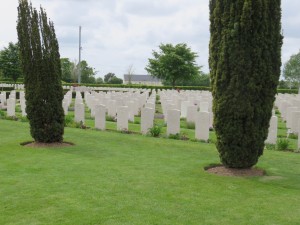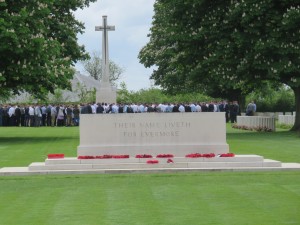Walking into the American Cemetery in Normandy was one of the most moving experiences I’ve had. Before reaching the actual cemetery, we walked through a museum that told the stories of some of the people that were buried there. Many of these people left behind wives, children, and parents. They were truly courageous people with many having great lives that they were never able to fully live out. One of the most touching stories was of the Niland family. They were four brothers, Robert, Preston, Edward, and Frederick Niland, from Tonawanda, New York. Robert and Preston died within the first two days of the D-Day invasion, while Eddie went missing just a few days later in the Pacific. Robert “Bob” Niland was killed on June 6, 1944 when volunteering with two others to help hold off a German advance; he was the only one of the three who died. Preston was killed near Utah Beach the next day. Edward Niland went missing on May 16 after he parachuted out of his aircraft. He was captured as a Prisoner of War by the Japanese in Burma and was not known to be alive until he was released a year later in 1945. The only known brother alive at the time was Frederick, who was returned back to the United States to finish the rest of his service there after the tragedies of his three brothers. There is a quote by Stephen Adly Guirgis that says, “No parent should have to bury a child….No mother should have to bury a son. Mothers are not meant to bury sons.” Within a month, a mother was left with the possibility of burying three of her sons. The story of the Niland brothers is the basis for the movie “Saving Private Ryan.” Although the most well-known and perhaps most unique story, this is not the only family that suffered harsh tragedies. Just about every family lost multiple people throughout the war and thousands of mothers had to bury their sons.
As I walked through the entrance to the actual cemetery grounds, the wind blew around me, and it felt as if the ghosts of thousands of people were still flying about. The cemetery was filled with over 9,000 graves of fallen American soldiers. The crosses were lined up perfectly and seemed to go on forever. The gravestones just displayed the soldier’s name, unit and division, the state that they were drafted in, and the date of their death. Many of these crosses covered the graves of soldiers that could never be identified. Seeing the massive size of the graveyard and realizing that it wasn’t even one percent of the amount of people to die during the war is pretty striking. It just seemed as if so many lives were wasted.
Although the American Cemetery was very hard to walk through, the British one in Normandy was even harder for different reasons. The American cemetery grounds seemed to place more emphasis on the sheer number of people killed in the war, although they did acknowledge individuals in the museum section before heading outside. They didn’t have dates of birth or the soldiers’ age when they were killed, and they didn’t have anything really personal on the actual gravestone itself. The British one, however, albeit being smaller, was much more personal on each one. It gave the age of their death and a personal quote from the family of each soldier on every gravestone. I remember one in particular saying something along the lines of, “In remembrance of a great father and an even better daddy.” The quotes on them really helped to give a much better perspective of the fact that each person was different and a unique individual; they all had families that they left behind. The ages also helped to put me in their shoes even more. Many of the people buried were only 18, 19, or 20. They were younger than I am. I feel like I still have so much of my life left to look forward to. It’s really hard to imagine not even living to the age that I am or my younger brother is. If I lived in that time period, it’s very likely that I would have been buried in one of these cemeteries myself.
So many people died much too young during World War 2 and although their sacrifice was honorable and important, the sacrifice of so many people’s lives is not something that we should ever want to come to. Hopefully we can all look back and learn from our mistakes and prevent such evil from rising to power again; and prevent ourselves from having to build more cemeteries on the scale of these ones.


